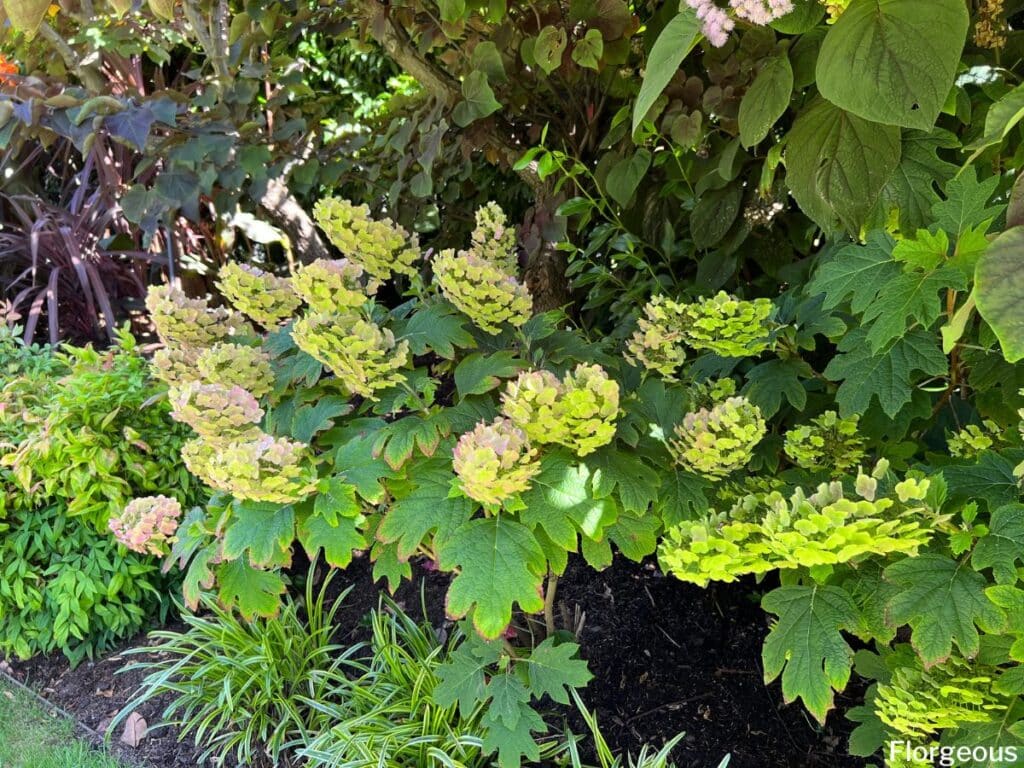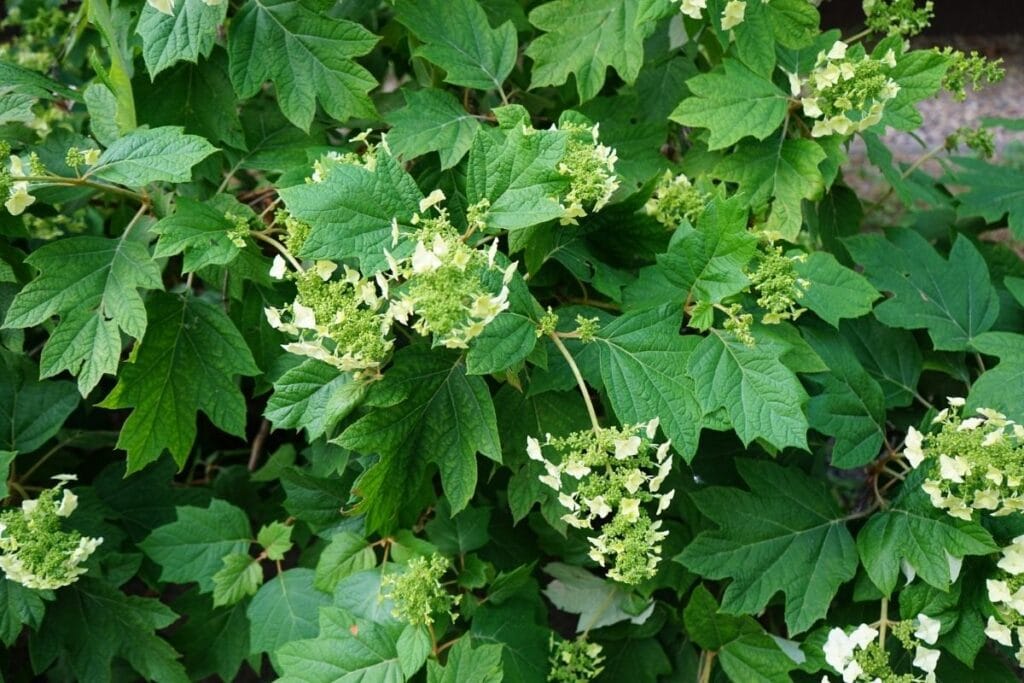If you are looking for a beautiful shrub to add to your landscape, look no further. The oakleaf hydrangea is the plant for you.
This plant can thrive in many different regions as long as you adjust your care methods for the region you are in, so it is an option for everyone.
Apart from the wonderfully large dark green foliage that give it its name, it also flowers with large white conical shapes emerging from the plant. Not to mention, if the standard oakleaf hydrangea Is not appealing to you, there are many different cultivars that you can look into.
What is Oakleaf Hydrangea?
Oakleaf hydrangea, or Hydrangea quercifolia as it is known in the scientific community, is a tough shrub that does well in the shade. This plant flowers in the summer, with its flowers shooting out from cone-shaped structures on the plant.
These oakleaf hydrangea flowers start off as white but may change to pale pink or purple over the course of a few months. It keeps its leaves until early winter when they fall off and show off its branches and stems. Then in the spring, the plant regrows its deep green leaves and textured silky hairs.
The name of this plant comes from its uniquely shaped leaves. Wide, dark green, and shaped like oak tree leaves, the leaves of this plant add interest to any landscape. These leaves can reach up to twelve inches long. Typically longer leaves grow on plants that have lots of afternoon shade. In the fall, the leaves turn red, brown, and purple, which may hang onto the plant until winter before falling off.

How to grow Oakleaf Hydrangea
The first thing to pay attention to for these specimens is the location you are planting them in.
The oakleaf hydrangea shrubs are happiest in areas with a lot of shade. You also should look into the condition of your soil. This deciduous shrub will do best in fertile, well-drained soil.
Another thing to keep in mind is that this plant is sprawling. Be sure to leave plenty of room for it so send up new shoots and spread. If you would like a plant that does not spread, try exploring other plant options.
This shrub is one that can grow just about anywhere and in any kind of conditions, from full sun to complete shade, although the medium shade is the best. Otherwise, your plants will likely require more shade. However, if you live closer to the coast, they can handle more sun exposure.
How to Plant Oakleaf Hydrangea
When you are planting Hydrangea quercifolia, make sure you leave the root fare, or the widening part of the stem, visible from the surface.
After planting, water the shrub with two gallons for every inch of trunk diameter for the first two weeks. You should focus your watering on the root flare.
After the first two weeks, continue to water the same amount every other day for two months. Weekly watering should be done after the two-month mark until the plant is established. Once Hydrangea quercifolia is established, you should not need to water it on a strict schedule anymore.

Caring for Oakleaf Hydrangea
Once your oakleaf hydrangea is planted and established, it requires little care. Make sure you water it during long dry periods to keep it from drying out.
Hydrangea quercifolia also does well surrounded by mulch. Make sure the mulch does not touch the base of the stem but give a good three inches of mulch layered on the surface. Reapply mulch in the early summer to maintain a cooler yet moist environment that the shrub thrives in.
You should also prune your shrub from time to time. Typically, the best time to do this is right after they have flowered in the fall or early winter. The best way to do this is to prune the older parts of the plant after the shrub has flowered. You should aim to remove no more than a third of the whole plant or less to avoid cutting off the flower buds for next year.
Here are a few more hydrangea bush care tips you can follow:
Watering
The thickness and hairiness of the oakleaf hydrangea help the shrub retain moisture, so this plant does not need to be watered as frequently as other plants. The best way to keep your Hydrangea quercifolia shrub happy is to water thoroughly, then check the soil by hand to test if it is still damp.
If you still feel moisture, wait a few days to water again. If the soil is not damp to the touch, you can water again.
Your oakleaf hydrangea will be happiest in moist soil that is not overly soggy. It is important to remember that overwatering may cause rot on your oakleaf hydrangea.
Weeding
Due to Hydrangea quercifolia’s large size, the area beneath the plant is well-shaded. This means that very little weeding is necessary to keep this plant thriving.
Also, the three to four inches of mulch around the base of the plant serves another purpose apart from keeping the plant moist and cool – weeds will struggle to grow up through it.
Therefore, Hydrangea quercifolia is a great low-maintenance shrub. This would make it a great option for anyone who wants a beautiful landscape, but who doesn’t have a lot of time to spend out in the garden.
Fertilizing
Hydrangea quercifolia prefers moist, fertile soil. If you want to know exactly what your oakleaf hydrangea needs, try getting a soil test kit, which is usually available at hardware stores or garden centers.
Your soil should be between a pH of 5.5 and 6.5, or slightly acidic soil. If your soil does not fall into this range, you can add different materials to help change the pH level. If your soil has a pH higher than 6.5 or is too basic, you can add liquid soil acidifiers to lower the pH level. If your current soil has a pH lower than 5.5 or is too acidic, try adding wood ash or agricultural lime to raise the pH.
After you have achieved a soil pH level in the desired range, use a 10-10-10 granular fertilizer to the soil. You should add the fertilizer to the landscape once in the spring and once in the summer for the best results.
Pests and Diseases
These plants are relatively unaffected by pests. However, they are somewhat susceptible to leaf blight and powdery mildew. Powdery mildew tends to strike hydrangeas that have been affected by drought. So, you can try to prevent powdery mildew on Hydrangea quercifolia by watering every four to seven days during periods with no rainfall.
Leaf blight, on the other hand, spreads more easily in moist climates. The bacteria transfer from one plant to the next through watering. If you notice leaves with spots on them, remove them from the plant immediately to prevent spreading.
Also, avoid pruning oakleaf hydrangeas or working on the shrub at all when it is wet. If you do, you will likely spread the infection from one specimen to the next by passing the water along.
Aphids and spider mites may also find their way onto these plants, and deer love to eat them. Like other hydrangeas, all parts are slightly toxic if ingested for humans.
Other Tips for Growing Oakleaf Hydrangea
While you can grow the oakleaf hydrangea bush in full shade or sun, the best option is partial shade. A little more sun will bring you more beautiful flowers in the fall.
When choosing oakleaf hydrangea companion plants, you need to make sure they meet the soil and sun requirements.
If you have a smaller area and have planted a larger variant of Hydrangea quercifolia, be sure to prune them early to keep them small enough for their space.
Oakleaf hydrangeas require little water, but if you live in a dryer climate you will need to water more frequently. The humidity of some locations helps the shrub retain water for longer periods of time.
Types of Hydrangea Quercifolia
If the typical oakleaf hydrangea does not sound appealing to you, don’t be discouraged yet! There are many different cultivars that are suited to different landscaping needs.
‘Pee Wee’
If you need to fill a smaller space, ‘Pee Wee’ may be a good option for you.
As the name suggests, this hydrangea stays much smaller than other types of hydrangeas. With this plant, you can expect about four feet of height and three in width. In the fall, the green foliage of this plant turn orange, red, and purple.
‘Snowflake’
‘Snowflake’ is a midsized option, reaching between four and six feet in height and width. The
‘Snow Queen’
‘Snow Queen’ is another option, growing to four or five feet in height and six feet in length. The flowers on this plant shift from white to pink over the course of the summer. In the fall, the leaves of this plant are a deep orangey-red color.
Once it loses its leaves, it will reveal the wonderful red-brown bark color it had been hiding.
‘Alice’
If you have a large area you would like to fill, ‘Alice’ is the choice for you.
As one of the largest varieties, this plant can reach up to fifteen feet in both height and width. The flowers on this plant begin as white, fade to pink, and end their cycle as a pinky-bronze color. In the fall, you can expect purple and red leaves.
FAQs
How do I get more blooms on my oakleaf hydrangea?
To encourage more blooms on your oakleaf hydrangea, ensure it receives adequate sunlight (preferably morning sun), prune it after flowering to remove old wood, and fertilize it with a balanced fertilizer in early spring.
Why are my oak leaf hydrangeas turning brown?
Oakleaf hydrangeas may turn brown due to various reasons such as overexposure to sunlight, insufficient watering, or fungal diseases. Ensure they are planted in well-draining soil, provide adequate water, and monitor for any signs of disease.
How do you rejuvenate oakleaf hydrangeas?
You can rejuvenate oakleaf hydrangeas by selectively pruning out one-third of the oldest stems each year after flowering, ensuring to remove dead or diseased branches, and providing regular watering and fertilization to promote new growth.
Can oakleaf hydrangeas be rooted from cuttings?
Yes, oakleaf hydrangeas can be rooted from cuttings. Take cuttings from semi-hardwood stems in late spring or early summer, dip them in rooting hormone, and plant them in a well-draining soil mixture. Keep the cuttings consistently moist and provide them with indirect sunlight until they establish roots.
Conclusion
Clearly, Hydrangea quercifolia is a special type of bush. These plants are known to be drought tolerant, making them a resilient choice for various garden conditions.
A beautiful garden is a wonderful thing to strive for, and with this plant, it is easy to achieve. Hopefully, you found this guide useful on your way to planting a shrub that will give you wonderful views throughout the year.
Learn more about hydrangea flower meaning to see why people love this plant!
References
*image by cristaldream/depositphotos






